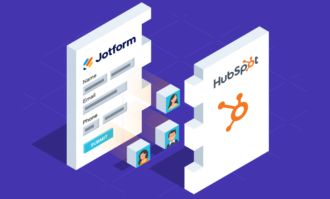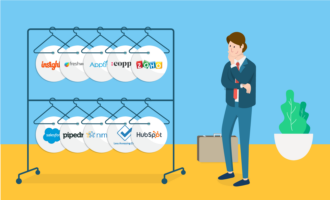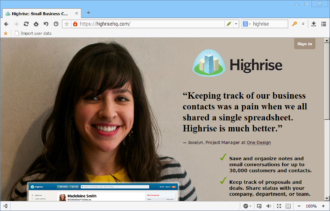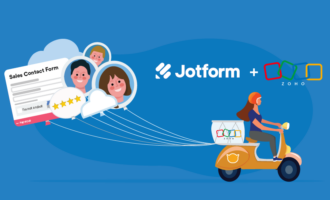What is CRM? CRM software is a modular technology system that includes sales automation, analytics, and marketing automation tools to gather customer data and empower sales teams to work at peak efficiency.
Customer relationship management solutions have become a mainstream part of the business world. CRM systems let organizations track customer data across channels, keep team members informed of user activities, and eliminate excessive manual work gathering information from clients.
With the rise of cloud-based CRM solutions, the technology has become more accessible, even for small businesses, and advanced functionality is becoming the new normal across a wide range of industries.

Grand View Research found that businesses are moving toward increased use of cloud CRM solutions in order to improve customer retention. The technology accomplishes this by
- Improving data management throughout the customer lifecycle
- Providing greater visibility into customer behaviors
- Allowing for better, more efficient service
- Supporting geolocation functions that enable organizations to provide location-specific services
- Incorporating marketing and sales force automation to streamline operations
- Making data available across organizational channels to keep everybody on the same page
These capabilities make CRM systems invaluable in the increasingly digital business world. According to Grand View Market Research’s study, companies from a diverse array of industries are increasing their use of CRM platforms to keep pace with emerging customer and operational demands.
How CRMs are evolving for the digital age
Digital transformation is the big buzzword for businesses today. The term refers to the process of moving from the use of disparate digital technologies to embracing a digital identity that optimizes data, processes, and human interactions around digital capabilities.
To a great extent, this transition is taking place because consumers have embraced digital solutions as a major part of their day-to-day lives. As consumers interact with brands across digital channels, businesses need to respond quickly and efficiently. CRMs lay the groundwork for positive customer experiences in a digitally transformed world, giving businesses access to the data and backend capabilities they need.
A CXO Today report explained that CRM functionality continues to evolve in response to this digital revolution. The technology is shifting to support deeper use of data mining, built-in social functionality to drive collaboration, and dedicated customer-facing tool integration to allow for faster response. These types of solutions will continue to drive CRM adoption moving forward and further entrench CRMs as critical technologies in the modern enterprise world.
What to expect from a CRM implementation
In practice, a CRM system has the potential to transform your operations by giving your employees the tools they need to engage with customers and one another as efficiently as possible. However, getting there involves a potentially tricky implementation process. We’ll go into more detail about what actual CRM use looks like later on, but in the simplest terms, you’ll need to consider the following when implementing a CRM:
- Expect a complex purchasing process during which you compare multiple solutions with similar features to identify the best option based on price and specific capabilities.
- Be prepared to deal with service-level agreements and pricing structures built around resource consumption and the number of users accessing the system, not one-time purchasing costs.
- Ensure you account for time to train employees and get them on board with the new solution.
Implementing a CRM is a big decision. You can expect the transition to be demanding. Keep reading to learn more about CRMs and what they can do for you so you can simplify the process and get your project off on the right foot.
Why CRMs are important for businesses
If you’re running a business or managing a team today, you’ve probably seen the effects of digital technologies. We’re all used to instant access to apps, data, and similar services on our phones at all times. We now expect businesses to be just as accessible. As a result, organizations are left scrambling trying to update their processes to keep up with today’s demands.

In a 2018 McKinsey & Company survey, approximately 80 percent of businesses said they’re working on digital transformation. However, less than a third of those businesses report that their efforts have improved operations and that they are sustainable over time.
CRM technologies are at the center of this movement. They’re among the first technologies to emerge as accessible options for digital transformation, and they’ve become essential as companies try to adapt to today’s digital demands.
So who uses CRMs? Just about any business can find value from the software.
Data: The bedrock of CRM value
Consumers are asking for custom, personalized interactions with businesses. A Forbes report highlighted how retail giants like Amazon are using data analytics to create strong, personalized experiences that give customers what they want in convenient, accessible ways.
The move to custom, individualized experiences isn’t exclusive to retailers, and it isn’t simply a matter of recommending products or services like Amazon does. If you want to offer personalization, you’ll need your business to get better at gathering, communicating, and analyzing data.
Improving support processes
Imagine one of your customers emails your business for help and then calls. Unfortunately the person they talk to is unable to access the email they sent. They talk with your support representative and provide a bunch of information, only to be passed on to a higher-level support engineer who proceeds to ask them to repeat all of the same information over again.
This kind of negative customer experience happens all the time in both B2B and B2C settings. Team members don’t always have access to the same data, and they often have trouble communicating with one another.
CRM systems overcome this challenge by creating a single source of data that can automatically send updates and notifications to stakeholders, saving employees from missed updates that lead to negative experiences.
Driving better sales recommendations by tracking pitches made over time
Have you ever been in an awkward meeting where a new member of your team spends five minutes going through a detailed product pitch to a client only to have the customer respond that they heard the pitch two weeks ago and, while they like the idea, they simply don’t have the budget for it?
These types of experiences can leave clients feeling that they weren’t important enough for you to properly prepare for the meeting. This makes your organization look disorganized and unprofessional.
A CRM deals with these issues by tracking all meetings, who was at the sessions, and what was discussed. A new stakeholder can hop into the CRM and get a quick update on what products have been pitched, how the client prefers to interact, and other key data points that allow for better experiences.
Creating end-to-end visibility into customer-related operations
How easily can you track how a lead was generated? What about the cost of acquiring customers? Can you quickly assess the average time from initial contact to sale?
Sales and marketing teams in today’s digital-focused businesses depend on complex, multilayered metrics more than ever before. That’s why it’s vital to gather information in near real time, communicate it to relevant sources, maintain data quality, and create custom reports.
CRM solutions can do this through a blend of database systems, automation tools, and reporting capabilities that provide more valuable data and help you better understand how your operations play out in the customer relationship.
In practice, digital transformation is all about creating better customer experiences. You need data to do that.
Without the right information in the right place at the right time, your workers can’t meet the needs of customers who may email you one hour, call you the next, and complete a transaction on a mobile app later in the day.
If all of this data is spread out in different databases and content management systems, your teams will be unable to respond to customer demands as they arise. If the information is funneled into the CRM software, your teams can manage customer interactions from a single place.
Key CRM software value propositions
Today, companies can’t get by without the ability to leverage data in everyday operations. But CRM software isn’t just a database. By delivering information in line with specific workflows, the technology is a natural fit for various tasks and teams. A few prime areas where CRM platforms are particularly valuable include
- Lead generation. Data gathered within the CRM system can identify how customers heard about a brand in the first place, why they initiated a relationship, when they moved from exploring options to seriously considering a purchase, how they interacted with sales (the number of meetings, website sessions, etc.), and what they actually purchased.
CRM software is the bedrock for tracking lead generation, qualification, and conversion in a cohesive way.
- Marketing automation. A CRM platform can integrate with popular marketing automation solutions to create a holistic option for deeper marketing penetration, process automation, and efficiency gains across your teams.
- Reporting. CRM systems typically provide a number of preconfigured, easy-to-create reports that you can quickly distribute to stakeholders. Most CRMs also feature custom report generation tools that let you easily gather custom data sets, often sorted by date or other parameters based on your needs.
The technology allows you to create visualizations that make the data more digestible and actionable. In most cases, this includes incorporating personalized data visualizations on user dashboards so that users can see key metrics at a glance based on their job role.
- Clerical automation. How much time do your sales, marketing, and support teams spend notifying one another of account updates, reporting to each other during meetings, and dealing with data quality across departmental lines?
A CRM system eliminates these problems: Once data is entered, it is automatically communicated to relevant stakeholders or logged into the right systems, all without duplicate manual data entry. CRM software can also automatically pull data from emails, messaging apps, and similar systems to further reduce the amount of clerical work businesses must do.
While these are the essential benefits of CRMs, many businesses find that CRMs can solve specific problems that are unique to their sales and marketing processes.

3 key types of CRM technology
CRM software typically falls into one of three broad categories, which often overlap.
1. Operational CRM
An operational CRM system’s features and capabilities improve operations to drive better customer experiences. They emphasize automation and similar capabilities that help employees get the job done better and more efficiently.
2. Analytical CRM
Analytical CRM systems are primarily devoted to data analysis. They gather information from diverse sources, offering backend analytics functionality, and delivering information to relevant users. These systems are ideal for businesses looking to gain greater insight into their sales and marketing units.
3. Collaborative CRM
A collaborative CRM system, as you’d guess from the name, helps employees work together more effectively. The software’s applications and tools are designed to help siloed business units break down long-standing operational barriers and drive better communication.
Most CRM platforms in use today will incorporate a blend of all three capabilities. A solution may emphasize one or another, but few lack features from these categories.
Common CRM system features
Specific capabilities can vary substantially between CRM platforms. However, a few of the most common features in CRM platforms include
- Contact management
- Quote and order management
- Social media integration
- Reporting
- Email integration
- Sales analytics
- Mobile accessibility
- File and document management
- Marketing and support automation
- Interaction tracking
These core capabilities come together to provide a holistic view of sales and marketing operations, letting teams track customer interactions across the pipeline, both before and after the sale. While this is not an exhaustive list of what any CRM platform can do, it provides an idea of how deeply ingrained the technology can be in any business.
CRM systems aren’t just lofty analytics solutions. Instead, they offer real, tactical capabilities that align with key operational pain points teams face every day.
Now that you have a clearer idea of why CRM solutions matter and what they do, it’s important to find the right solution for your needs.
How to find the right CRM
There are a lot of CRM providers fighting for market share right now. Look at some of the best CRM software options on the market, and you’ll quickly find a blend of longtime players promising powerful tools and emerging players claiming to disrupt the status quo and give businesses what they really need.
In many cases, these solutions share many standard features. It’s important to explore the technology’s specific functions and the industry it was designed for. This can make it easier to narrow down options to a reasonable list. However, before you get there, you’ll need to be sure you understand cloud-based CRM systems.
The benefits and pitfalls of cloud CRMs
At this point, the cloud is mainstream, making traditional CRMs all but extinct. With that in mind, it’s vital to understand key benefits and pitfalls that come with using this technology. (We’ll do a deep dive into the cloud later on in this guide.)

Benefits of cloud CRMs
- Flexibility to add new features or scale your use of the technology with ease
- Lower capital costs with the initial purchase
- No need to manage or maintain servers and other data center hardware to support the system
- Easier integration with other cloud apps and services through modern APIs
- Simpler transitions between solutions as you don’t have to deal with data center disruptions or installation on end-user machines
- Accessible to users logging into the CRM from locations outside the office
Pitfalls of cloud CRMs
- Potentially higher long-term costs as you pay for subscriptions and deal with possible fees if your usage needs exceeds the limits of your service level agreement
- The need to trust a third-party service provider with vital data that must be available to employees at all times
- Extra stress on your network as all data involved in the CRM moves through the internet instead of being stored on end-user devices
- Reliance on the CRM provider’s development road map for new features and capabilities
These pros and cons are an unavoidable part of cloud CRMs. You’ll need to keep these issues in mind when choosing a platform and look into how the solution provider enhances the advantages of the cloud while addressing the potential problems.
Major players in the CRM sector
There are a variety of CRM options out there; here’s a look at five of the most prominent players in the sector:
- Salesforce. Salesforce dubs itself the top CRM in the world, claiming to be used at more than 150,000 businesses of all sizes. The solution focuses on ease of use, giving organizations a streamlined road map to implement the technology, customizing with varied cloud apps and services, and empowering employees to collaborate effectively.
- Oracle. As one of the world’s leaders in database development and analytics, Oracle delivers a CRM backed by deep data ecosystems and access to a variety of its cross-channel commerce solutions.
- SAP. Like Oracle, SAP brings a long history of analytics excellence and streamlined integration with diverse cloud tools to the CRM space.
- Microsoft. The Microsoft Dynamics 365 platform provides core CRM functionality in a package that integrates with Office 365 and the rest of the Microsoft cloud. This powerful integration allows for easy scalability within the platform and brings the familiarity of Microsoft interfaces to the CRM space.
- HubSpot. While HubSpot is especially well known for its dedicated sales and marketing software, it also offers free CRM tools that make the technology particularly accessible to businesses of any size.
This is just a snapshot of some of the industry leaders in the CRM space, but exploring each can give you a general idea of what the technology does and how it does it.
Key tools and features in contemporary CRM systems
Each CRM is going to offer different features and methods to complete a task. But core CRM functionality ultimately boils down to three key ideas:
- Automation. Modern CRMs automatically compile data and perform deduplication to ensure the information you have about customers is accurate and up to date at all times. The technology can also be configured to send users alerts or provide dashboards that automatically notify team members when there’s a task they need to complete.
CRMs don’t just manage key data in the backend; they capture it from various sources and deliver it to the other apps and services you use.
- Integration. Today’s CRMs are built in the cloud and typically designed to work easily with other apps and services in a cloud provider’s ecosystem.
Whether it’s direct CRM integration within a cloud platform or one that uses APIs to grab data from a source like social media, integration tools let the CRM access customer data or process updates and log them in near real time to ease the operational burden on end users.
- Reporting. Gathering information from diverse sources and integrating that data with end-user apps is great for day-to-day operations.
Built-in reporting tools make CRMs invaluable from a strategic standpoint. The technology uses the customer and operational data it manages to compile reports on key metrics and benchmarks you want to track.
You can typically use CRMs to create custom reports as well. The software can prove vital in helping you gain deeper transparency into your business without a great deal of manual data gathering and analysis.
These three pillars of modern CRM technologies lay the groundwork for smaller features that you’ll want to explore as you dive into the specific solutions on the market. Understanding the core functions available can make it easier to investigate how different vendors achieve these capabilities and assess their fit for your needs.
Accounting for scalability and flexibility
How much do you expect your business to change in the coming years? Cloud-based CRM software should be able to scale based on your resource needs.
Adding new users to the subscription or handling more data isn’t a huge hurdle. But if you have unpredictable needs, you should explore the billing models used by different vendors.
Some solutions may allow for more flexibility without high costs. On the other hand, some vendors may increase their prices when you unexpectedly need more resources. As you weigh your vendor options, think about where your business stands in terms of the predictability of data storage, analytics needs, and the number of users in the system.
In terms of flexibility, talk with solution providers about their development road maps and how they prioritize adding or tweaking features based on feedback. Chances are there won’t be a system that has every single feature you want out of the box. You’ll probably either need some customization or have to look out for capabilities that the provider doesn’t offer. It’s important to understand the vendor’s approach to ongoing development so you aren’t surprised after making a purchase.
Choosing the right CRM for your needs is ultimately going to come down to identifying must-have features, capabilities you’d like, and functionality you don’t care about. From there, you can blend those specifications with your budget requirements to create a short list. Once you have a base, you can start going through sales demos and getting to know vendors to further explore your options.
The importance of CRM integrations
Integration is central to CRM value
Serving as a single source of data is the key purpose of a CRM system. If you’re considering the technology, you need to think about how it integrates with your existing systems to make sure it can function as your data hub.
You can’t have a dedicated marketing automation platform with its own set of customer data while your customer support team has separate account tracking software and your financial teams have yet another distinct record of customer information.
Think about trying to get by with customer data located in three distinct places. Your teams would all enter information manually in disparate systems, duplicating data on the same clients and storing that information separately. The result would not only be potential confusion, but also difficulty in tracking customer interactions across channels.

With a CRM platform that serves as a central warehouse for customer information, you can log relevant information once, and then it’s automatically visible to users on relevant teams. Generally speaking, you can add notes and use separate data fields for customers to clarify any key points of distinction, such as a client who wants to receive billing information at a different email address than marketing content.
The big-picture integration offered by CRM tools — gathering data from various apps, centralizing that information, and making it available to users in relevant ways — is central to getting value from the technology. However, more nuanced integration capabilities have emerged as CRM software has matured, adding a greater degree of convenience, data transparency, and operational efficiency.
Beyond basic integration: App integration and APIs
Before exploring the opportunities of CRM software created through app integrations and APIs, let’s focus on distinguishing what we’re talking about when we use these terms. Though they aren’t quite interchangeable, they have many similarities.
App integration. Application integration is when a CRM system and an application are able to work directly alongside one another, taking elements of the CRM solution or the discrete app and displaying them directly in the user interface.
APIs. An application programming interface is a prebuilt set of tools that allow a portion of an existing app to be used within another system.
App integration and APIs deliver value in the same way — by bringing functionality from various apps and services into the CRM system or bringing CRM capabilities into another application. This leads to huge efficiency gains, as it saves users from having to switch between multiple applications to complete a task.
Earlier in this guide we talked about how CRM software is a key component of digital transformation programs. These integrations are an essential part of this process. They ensure that users can get multiple tasks done through a single interface, making it much easier for them to meet customer demands.
The list of integration options could go on and on, but there are a few common ones that stand out.
Common CRM integrations and APIs
Let’s look at some of the options you should expect from a modern CRM system and a few specific examples to show the types of things a CRM integration can accomplish.
Email integration
Integrating your CRM with your email system is one of the most useful integrations. Imagine you’re a salesperson trying to set up a meeting in response to an email from a prospect. You open the email and get the request for the meeting, then have to jump into the CRM system to explore the prospective customer’s history and a record of how you’ve marketed to them.
From there, you go back to your email and write a message that is personalized based on that history, and you try to schedule a session. Then, you go into your calendar and block out time. Finally, you open your conference call application to schedule the call.
Now imagine going through that same process with email integration. You get the email, and a CRM interface built into the email either automatically links to the prospect’s record or displays key information on your screen. You can send the reply from there, and the CRM solution can grab the data for call scheduling and automatically create calendar holds and conference lines.
A task that would require a bunch of manual steps involving multiple apps is handled through a single interface, automating the bulk of the clerical work. This allows you to focus more of your time on personalizing your message to the client, not on worrying about the details.
Of course, this is just one example of how email integration can work. Building this kind of CRM functionality into your email results in several key capabilities:
- Setting reminders to contact customers on certain days in the CRM, based on your sales process or client requests, and getting notifications in your inbox
- Displaying key sales and marketing data within the email interface so you can avoid faux pas, such as trying to sell a customer something you recently pitched or assuming a client is using one of your products when they aren’t
- Automating updates to team members to ensure relevant stakeholders are always informed
- Logging email communications in the CRM system so all parties involved in managing the client relationship can see a history of interactions
Email is a hub for enterprise communication, and CRM software integration with email, calendar, and conferencing solutions will help you get even more value from messaging.
Analytics integration
CRM systems provide reporting and basic analytics, which helps you gain a stronger understanding of your day-to-day sales, marketing, and customer support efforts.
However, deeper analytics capabilities, such as machine learning, artificial intelligence, and similar capabilities that require larger amounts of information, are often separate from CRM solutions.
Some tools will provide a few features that qualify as advanced analytics, but the real value comes when the CRM software integrates with other databases to create large, valuable data caches that you can use to get to know your customers.
Integrating with various databases and dedicated analytics solutions lets you dive deep into using data as a competitive differentiator.
Support platform integration
Customer support teams spend most of their time interacting with your clients, often trying to make them happy when they start out frustrated by something that isn’t working the way they expect it to.
Your support team frequently gathers large amounts of customer information during these interactions. If a client speaks with multiple support representatives and has to repeat the same information at each checkpoint, they can grow understandably frustrated.
Integrating your CRM solution with your customer support platform eliminates this problem.
Contact center representatives can get key customer data, such as which products the customer is using, how long they’ve been a customer, and key notes on demeanor, right on their screen when a customer calls.
The data is automatically displayed because the CRM solution recognizes the customer’s phone number and grabs the right information. Your support rep can take notes on the call and pass those notes on to higher-level support workers as the call is escalated.
All told, the integration between the CRM solution and support platform transforms how you interact with customers, driving efficient, positive experiences that fuel engagement.
App integration
There are a plethora of apps that can potentially integrate with a CRM system, either through an API or a direct integration. They can be social media apps, dedicated productivity solutions, or entire cloud platforms. Here’s a look at how Jotform integrates with CRM systems so you can get a feel for how app integration can add value to CRM platforms.
Jotform is an online form creation tool. You can use it to create customer surveys, registration and contact forms, payment invoices, booking documents, and just about any type of form you can think of.
Jotform features a variety of templates and lets you customize your forms. On its own, the solution is powerful because it lets you gather information intuitively via web and mobile interfaces, allowing for smoother customer interactions.
Integrating Jotform with a CRM system (like Zoho, Insightly, HubSpot, Salesforce, Solve360, Highrise, Clinchpad, Keap etc.) adds value by allowing the CRM solution to automatically pull data from forms.
If a customer fills out a registration form, the CRM software grabs the relevant data, notifies stakeholders, and updates backend systems with the customer data. Likewise, if you send out a customer survey, the CRM platform can pull customer responses into a central sheet and give you reporting tools so you can view that information in a cohesive way.
Though just one app that integrates with CRM software, Jotform is a prime example of the value that comes through automation and reporting with CRM databases.
How integration is handled
Traditional integration methods were limited. Before many CRM solutions were hosted in the cloud, you had to come up with your own solution, often writing custom code and going through complex development projects to get different systems to interact with one another.
In today’s cloud-driven world, app designers are increasingly using API tools or streamlined development capabilities to ensure their apps can integrate with major cloud platforms. A CRM solution that integrates with a cloud platform can also integrate with those apps, making it much easier to get data to relevant users in a streamlined way.
Why choose a cloud-based CRM?
What is cloud computing, and how does it work?
The cloud isn’t new, so you’ve probably heard a lot about it. The problem is that there’s a lot of hype and misinformation surrounding the cloud. Let’s get real.
Many small business owners see the cloud mentioned in tech commercials and hear about it on blogs, but they don’t necessarily have a concrete idea of what the technology actually is.
For practical purposes, “the cloud” is a term that the tech industry started using to describe where data goes when it is sent through the internet. The internet itself is simply a network of servers, all hosted in various data centers, that users can access by sending a message to the device’s host address, or web address.

When you’re using the cloud, you send your data through the internet to a server in a data center somewhere, and an application on that server processes and stores that information. This is a bit of a simplification, as there are other variables involved, but it’s a basic rundown of how the cloud works.
The main difference between this method of managing technology and traditional business software is in how applications and data are hosted. Instead of setting up a server in your office and connecting it to your local network, the application is hosted on a third-party server.
The cloud completely transforms how software is delivered to businesses. The benefits are evident in three key areas:
Cost benefits of the cloud
Imagine someone comes to you and asks you to purchase a year’s supply of groceries all at once to be delivered to you at regular intervals. Sure, you’d get the work of planning and managing weekly trips to the store out of the way, but you’d probably find it difficult to make such a large purchase.
This is what used to happen to small businesses when it came to robust technologies, like CRM systems. Organizations saw the value of the technology but couldn’t afford to buy servers, hire IT staff, install network equipment, purchase software licenses, and get everything running. It simply wasn’t realistic from a financial perspective.
Now imagine someone comes to you with the same grocery plan, but instead of paying in a lump sum, you pay a monthly fee. That’s a much more accessible solution, and it’s what cloud computing offers.
You don’t have to buy the hardware. You don’t have to hire IT staff. You don’t have to make data center upgrades in your office. All you do is subscribe to the software, and it’s delivered to you through the internet.
Cloud computing is the reason technologies like CRM software are even possible for smaller businesses. But this doesn’t mean the cloud is cheap.
In fact, cloud CRM solutions may be more expensive in the long run because an ongoing subscription can add up to more than a one-time purchase for technology that lasts for several years. However, the subscription model makes the costs manageable and creates the added benefit of flexibility.
CRM system flexibility and scalability in the cloud
Imagine what your business’ IT setup looked like in the past. You probably had dedicated servers to host software and paid for licenses on an individual basis.
What would it have taken to expand your CRM system, add new functionality, or transition to a new solution in such a setting? The cost and time commitment for that kind of change would have been huge. That’s a major reason why businesses were somewhat slow to innovate in the past.
In the cloud, all of these barriers are gone. If you need to add users to your cloud-based CRM system, you simply change your subscription. If your current solution isn’t meeting your needs, you can migrate to a new one.
It isn’t always an easy transition, but it’s much more manageable than it used to be. The challenges come in training and user engagement, not making a huge, expensive technology overhaul.
Flexibility is where the cloud can be somewhat daunting. It’s possible to customize your experience with a CRM system in the cloud, but the extent to which you can do so relies on what the solution provider allows.
You could end up waiting for the cloud CRM vendor to make updates and changes; however, a provider should give you a road map of feature additions and development goals prior to selling you a subscription.
While you lose some control with a cloud system, you gain the ability to more easily switch between solutions, something that pressures vendors to make frequent upgrades and add modules.
When push comes to shove, the cloud is much more flexible and scalable than traditional CRM setups, but the loss of control is particularly notable when it comes to integration.
CRM integration in the cloud
Since we mentioned this earlier, we won’t go into it in depth here.
Integration can be easier to manage when dealing with cloud CRM solutions because apps and APIs need only integrate with the cloud setup, not with the CRM software and the hardware configuration where the system is physically hosted.
This allows for greater integration. Because businesses often have vastly different data center setups, integration used to require significant customization. In the cloud-computing world, those differences disappear, and integration is much more manageable.
The new cloud reality
It’s understandable if you’re worried about sacrificing control to take advantage of the cloud. But the technology has become pervasive in the CRM sector. In fact, it’s nearly impossible to find solutions that aren’t housed in the cloud. Even longstanding industry giants like SAP and Oracle offer cloud CRM options, and Salesforce gained prominence in large part due to its cloud offerings.
Concerns about hosting critical customer data in the cloud are common, but the technology has evolved to the point where most providers offer far greater security than small businesses can on their own. What’s more, service providers are often certified to comply with key regulatory standards.
Digital technologies are pushing organizations to change quickly and maintain a culture of constant improvement. A cloud CRM system makes that possible through continual updates and feature additions backed by an infrastructure that promotes scalability. These benefits create opportunities for business owners to innovate in ways that weren’t possible in the past.
How CRM automation transforms your business
What is CRM automation?
How many of the tasks involved in your workplace operations are completed the same way every time as long as you meet certain conditions?
For example, if a prospect reaches out in response to an ad campaign, a member of your sales or marketing team probably uses a response template to follow up and determine if the lead is qualified. If a user fills out a form on your website, you probably add them to a newsletter list. If a salesperson holds a meeting with a prospect, chances are you want them to log that meeting.
These are all repeatable and predictable tasks. They are also processes that require clerical work. Whether a sales employee is manually logging details of a meeting and updating a database or a marketing team member is adding an email to a marketing automation list, the manual task, even if it only takes a moment, is another thing your team members have to worry about. CRM automation tools eliminate much of that clerical work.

A lot of this automation stems from the integration mentioned earlier. For instance, if a salesperson sends a prospect a post-meeting recap email, the employee can log that email as an event recap in the CRM platform with just the click of a mouse — assuming the CRM system in use offers email integration.
A CRM solution can also pull data from calendars, productivity apps, conferencing apps, and similar systems to automatically update key data that is valuable to users but too time-consuming to gather and track manually. When all of that clerical work is automated, your employees can spend less time on monotonous work and more time focused on increasing sales.
How do CRM systems typically handle automation?
Most CRM solutions
- Analyze data from integrated sources in near real time
- Identify any notifications, documentation, or similar clerical tasks triggered by that data
- Automatically initiate the process or alert users of the need to take action
It’s a fairly simple workflow, but in terms of keeping up with the day-to-day demands sales teams face today, the benefits are significant.
Contextualizing automation for a digital world
You need to automate if you’re going to keep up with digital-focused consumers. There are now more points of contact with prospective and existing customers, creating new opportunities to strengthen relationships and create revenue.
The opportunities are great, but there’s also more pressure to stay in touch with more customers across more channels. That can leave employees struggling to keep up with the scale and complexity of everyday work. When that happens, documentation, data management, and other operational best practices vital to everyday operations can fall by the wayside.
When your CRM software automatically identifies duplicate data, your users spend less time logging customer details. When the CRM solution tracks calendar details to record when meetings took place and who attended them, sales team members can log recaps faster. These types of efficiency gains help employees spend less time focused on clerical work and more time working with customers and prospects.
CRM software and marketing automation
Is the automation offered by a CRM platform the same as what marketing automation software provides? Not necessarily. In most instances, CRM automation software offers some marketing automation tools, but these tools are not as robust as a full marketing automation platform.
Marketing automation solutions can manage entire campaigns automatically. Users set parameters and targets, and then let the system distribute content, track engagement, and report on progress.
A CRM marketing automation system can do some of these things through its marketing modules, but a CRM platform won’t replace marketing automation if you’re already using it. Instead, it lets you dip your toes into what the technology can offer.
You can get the best value when your CRM system integrates with your marketing automation platform. In this case, the automation platform does the heavy lifting of running the campaign, but the CRM solution serves as a central repository for that data and communicates it to relevant parties further down the sales and marketing funnel.
Automating security and compliance
Centralizing data can boost security and make it easier to comply with the regulatory standards for your industry.
On most sales teams, employees gather customer data, process payments, pass on details about clients to various team members, and take documents with them on the road as they go on sales visits.
The fast pace and frequent disruption in these tasks creates many opportunities for data theft and loss. All it takes is one employee to leave sensitive customer records at an airport, and you could have a major data breach.
CRM solutions store data in the cloud, so you don’t have to worry about employees accidentally exposing data. The only risk comes if their account is breached, which can happen, but is less likely to result from a simple, everyday error.
Plus, IT teams can configure permissions and workflows within the CRM system to ensure users follow best practices in accessing and managing data. It’s even possible to build compliance into your process through a blend of alerts, reminders, and mandatory processes.
In essence, CRM systems can automate security and compliance by letting you set best practices and then operating with those rules in the background.
Automating the customer experience
We previously covered how CRM software can integrate with customer support platforms to streamline communication between contact center workers. But as customer experiences become more complex and dependent on interactions across channels, businesses need tools that automate a wider range of support tasks, such as
- Allowing users to complete self-service tasks that solve their problems without input from support workers
- Managing content that helps users troubleshoot problems
- Creating virtual assistants that can search content and offer guidance on entry-level topics
- Enabling customer support employees to interact with users across devices and channels
- Giving customer support personnel constant access to the same customer data
The CRM platform is the central element of these capabilities. It provides the essential data infrastructure for automated services and enables users to share information.
Sales automation
Getting your sales team to work at its best is central to a CRM platform. These systems automate key sales processes by tracking deals in real time, automatically logging data at various points in a transaction, providing the background details needed to configure products and offer quotes, and tracking interactions at all stages of the pipeline.
CRM technology is built primarily for sales processes, and it frequently automates tasks performed on the backend. These gains may seem small on their own, but for sales teams at the office or in the field, automated data management is instrumental.
CRM basics and tutorial for beginners
How to use a CRM system
When it comes to actually using the technology, CRM software isn’t all that different than other apps out there today. You can expect it to be pretty intuitive, with dashboards that give you the key info you need and clear links to specific modules.

Here are some basic entry-level tips for what to expect when using a CRM system and how to interact with it:
- You’ll typically log into a CRM through a website or by opening a mobile app. It’s critical to set a strong password or alternative authentication mode. If an unauthorized user got into the system, they could steal data, mess with your information, and otherwise sabotage your sales team. Most attackers that target a business are looking for information they can sell, and the results of a breach can be expensive.
- Once you log in, you’ll see a user dashboard. Most CRM solutions will let you customize these dashboards based on the user’s role, but they commonly include a few key data visualizations to showcase key performance indicators, a list of tasks that need to be completed, key notifications, and a toolbar that lets you step into specific modules to get various tasks done.
- In the dashboard, you can click on data visualizations to get more information about the report. Clicking on reminders or notifications will take you to the relevant systems, and selecting modules will bring you to a dashboard for that module where you can take further action and see more nuanced data.
- Each module includes links to other parts of the application where you can take direct action, whether that’s simply reading information or updating data.
In practice, a CRM solution is fairly easy to use on a day-to-day basis. Much of the challenge actually stems from configuring the solution.
For example, you can use a CRM system to build a new sales automation workflow. Doing so typically requires that you select tasks, users, and data sources to trigger specific reactions. You can set up a workflow where every time a salesperson on your East Coast team responds to an email from a certain client, the manager is notified. This lets you maintain visibility into key accounts with less clerical work.
While you can run into some complexity setting up custom workflows and capabilities, how you do it varies substantially from one solution to another. Most CRM providers will offer training to help you get comfortable with the technology.
Core CRM modules and what they do
CRM software is generally built to be modular in nature, featuring different elements that focus on a specific team or process. This makes it easier to organize your data and operations within the CRM system and can allow you to pick and choose modules based on your needs and budget.
Most CRMs feature three primary modules:
Sales automation
The sales automation module focuses on empowering the sales team to work as efficiently as possible, gathering relevant data and communicating that information at relevant points in a user’s day. This can include everything from managing KPIs for greater visibility to ensuring transparency into product portfolios and pricing. The goal is to give sales teams the information they need to close deals with relevant information all in one place.
Marketing
The marketing component of a CMS system is similar to the sales module, but it focuses on the capabilities marketers need to manage interactions throughout the funnel. Working alongside dedicated marketing automation solutions, the CRM can expand its core capabilities, helping employees assess campaigns on an ongoing basis and keep prospects engaged.
Support
Creating a cohesive customer experience hinges on getting support team members the right data at the right time. CRM solutions make that possible by integrating with various contact center systems to provide key data during interactions and make it easier for team members to log the results of conversations with clients.
These modules aren’t the only options CRM platforms offer. Some include e-commerce-specific solutions, industry-specific functionality, or similar nuanced tools, but these three core modules are the essential components of most modern CRM automation tools.
Tech considerations for a CRM deployment
There’s some good news when it comes to preparing for a CRM system rollout: The CRM service provider meets the bulk of the requirements, leaving you with little to worry about.
That doesn’t mean you don’t have to do anything, but if you have visions of configuring servers, managing data center infrastructure, and dealing with complex system integrations, that isn’t likely. Here’s a look at a few things you must consider before implementing a CRM system.
Network capacity
Sending and receiving information from a data-rich cloud application like a CRM system is going to put a significant strain on your network. Most office LANs will be fine in this situation; the problem might be your internet service.
Getting more bandwidth is essential to support a CRM software rollout. There isn’t a hard and fast rule about data throughput requirements, as they can vary based on user count and other considerations, but you should pay close attention to application performance once the CRM system is deployed and be ready to upgrade your internet service plan if your network isn’t up to par.
Security considerations
While your CRM service provider will handle many security issues, it’s still up to you to determine best practices for user authentication, set standards for internal data sharing, and create a baseline for secure operations within the system. It’s not as much of a burden as hosting your own solution, but neglecting the part you play in securing data can have disastrous consequences.
Training for the new CRM software
CRM training can be tricky. On one hand, CRM solutions are fairly intuitive, and many users won’t need too much help. On the other hand, CRM systems offer broad functionality and may require specific methods to complete certain tasks. This makes strategic training critical.
Failing to get your users on board with a new platform can lead to declines in usage after launch, backlash resulting from the change, and diminished value of the system as a whole.
Successful CRM system adoption actually begins before you make a purchase. Get the employees who will actually use the system each day involved in the process to get their feedback on priorities. This will get them on board with the transition, and they’ll be willing to take time for training.
You can probably handle most basic user education with your own team, but CRM providers may also offer to bring in their own training support for some of the more nuanced capabilities of the system.
The key for training is to never consider it complete. The learning mindset should start before the sale and continue as updates and changes are made.
Conclusion
CRM software has changed the business world. As one of the first cloud-based technologies to be widely implemented, CRM systems have helped usher in an era of constant innovation. What’s more, you can get the technology more easily now because of subscriptions to cloud solutions. CRM systems aren’t just for big businesses anymore. The flexibility and efficiency that you get from CRM software is available to companies of any size, in any industry.
CRM platforms are accessible, but they’re still a big commitment. The technology is becoming a necessary component of operations as organizations work to embrace digital transformation. What’s more, a CRM solution isn’t just valuable for its core functionality. Integrations with digital apps like Jotform expand the functionality across your apps and services.
The business world is going through a digital revolution. Organizations need a solid foundation to provide data stability and organization as they work to adjust their processes. CRM solutions offer this foundation for your sales and marketing efforts, letting you gather and use data as effectively as possible.
Implementing a CRM solution may be a big change for your business. It will require some training and help to get used to a new way of working, but the benefits are too great to ignore.
The CRM sector is continually growing and evolving as business demands change, making the technology uniquely suited to help organizations respond to customer demands. At Jotform, we bring that same culture of constant improvement to digital form creation and management.
These technologies make digital transformation a real option for small businesses. They give you the flexibility you need to customize based on your needs and the functionality necessary to bring your company into the future.














































Send Comment:
12 Comments:
More than a year ago
The Importance Of Customer Relationship Management To Small Businesses
The goal of every business is to make sales and remain as profitable as possible. This can only be achieved through the active participation of customers. That means customer satisfaction, loyalty and retention are at the core of every enterprise, whether large, medium, or small.
More than a year ago
Sometime it becomes very hard to find a well written and well established blog which give you correct and useful information. However, I found this blog and got some relevant information about admission crm software which are really helpful for me.
More than a year ago
When i started my crm search i found this article, and it was a great resource in getting started with the crm world. I wanted to come back and thank the author for putting in the time writing this. We ended up going with Snapforce CRM, but I still have this article bookmarked on my browser.
More than a year ago
CRM software deals with an organization's collaborations and associations with both current and potential customers. improves the customer relationship through overseeing customer connection, following leads, and smoothing out cycles.
CRM stands for Customer Relationship Management and its all about managing a relationship with the customers with one central place.
CRM permits organizations of all sizes to drive development and benefits.
Truly, they're still basically intended for sales, marketing, and administration.
More than a year ago
Data is everything for our company.
Our boss specifically underlines the importance of data and how it can help our company grow nearly every meeting. At the end of the day, we are evaluated by our sales numbers. That is why every account manager should have the necessary information and trends of their customers. Using a CRM tool was one of the best decisions that been made since I started working for my company. Being able to see our customers' life cycles and behaviors leads to sales that would never be made if we weren't using HubSpot. The integrations also made our lives easier, a new lead/customer can be easily added from a data collection tool, we use Jotform, to our CRM tool, HubSpot.
One shouldn't forget that acquiring a new customer can cost five times more than retaining an existing customer. So investing in a CRM solution would definitely make sense in the long run.
More than a year ago
CRM is a very effective tool for business owners to be able to track and manage their entire business successfully. It's a solution to help businesses focus on their customer relationship while being able to offer a better experience for their customers.
More than a year ago
How might I get the a Demo Video to integrate jotform with Salesforce?
, I need some DEMO step by step to get integration, Please send me a fast way to get it
More than a year ago
A great read indeed, Lot of research went into this, Very unique writing style and as a reader, a lot of research went into this. Thanks for sharing.
More than a year ago
Well we tried some of CRM softwares in our company, actually what we finally sticked with is it is not that big company so they could focus more on us as a client and readjust the software especially for us, it is great cooperation up to this moment.
More than a year ago
CRM Software has many benefits for almost all kinds of businesses. I think every businessman should use crm software for their business. It will be helpful to grow your business and you will get more profits according to your expectations.
More than a year ago
CRM experts believe in the concept that a CRM system should let your business achieve an impact. This is necessary not to maintain your business alone, but also to let it grow. Achieving ‘impact’ has now become mandatory in CRM.
More than a year ago
Nice article. I love it